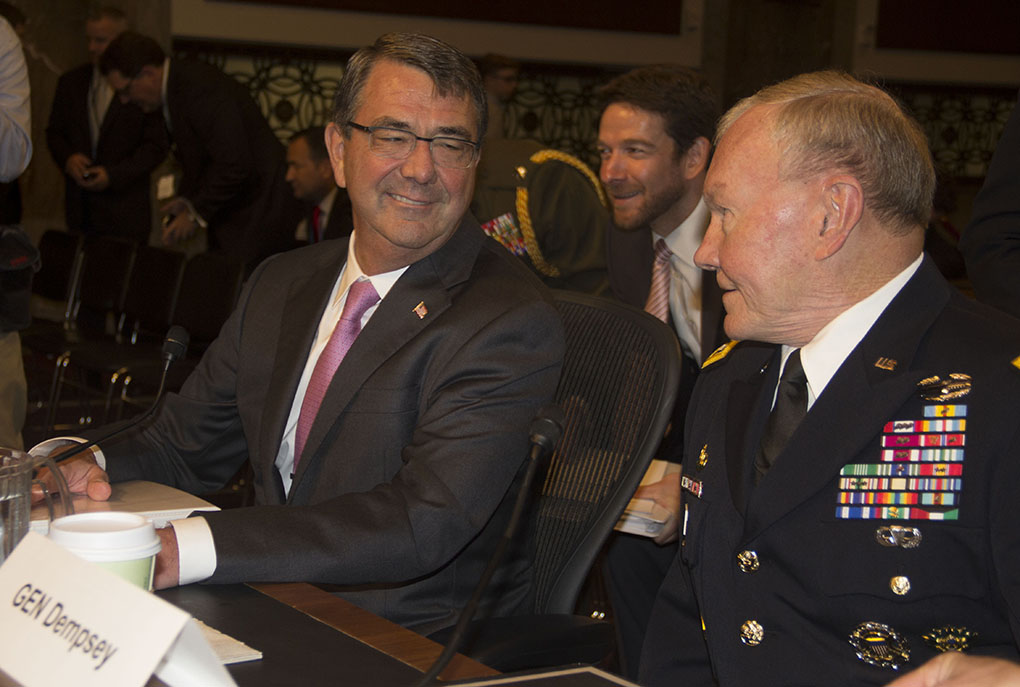
Secretary of Defense Ashton Carter and Joint Chiefs of Staff Chairman Gen. Martin Dempsey exchange pleasantries before testifying in front of the Senate Committee on Armed Services about U.S. counter ISIS strategy. (Matt Yurus / Medill NSJI)
WASHINGTON – Turkey and the U.S. agreed to a deal in late July that might lead to an ISIS-free zone along the Syrian-Turkish border while allowing the U.S. to launch airstrikes against the marauding jihadist organization from Incirlik Air Base in Southern Turkey.
There is not a plan in place, however, to create this buffer or safe zone, as it is often called. And Obama administration officials are reluctant to call what they expect to be a roughly 60-mile long and 40-mile deep area that nearly reaches Aleppo a safe zone.
The administration refers to this as an “ISIL free zone so that it would not have the perception of a safe zone protected as a no-fly zone,” said Ömer Taşpınar, a professor at the National War College and expert on Turkey. To implement a no-fly zone, the U.N. must pass a resolution, and Russia and China would veto it, and Iran would view it as a hostile act, according to Taşpınar.
Taşpınar pointed out that the agreement did not detail the type of zone that would be created. The Turkish media, however, has been reporting that the U.S. has finally agreed to a safe zone. So in this sense, it has been a public relations strategy, he added.
There are a lot of loose ends and potential complications, he said. The Turkish forces are hesitant to deploy ground troops without the protection of a U.S. and coalition-enforced no-fly zone. The Obama administration has refrained from sending in a sizable U.S. led ground force, instead choosing to train indigenous fighters, and these moderate Syrian rebels are too weak to police the area.
In early July, Secretary of Defense Ashton Carter told the Senate Armed Forces Committee that only 60 moderate rebels were in training, a force “much smaller” than expected. He expected that number to improve, however, saying that as the U.S. learns more about the opposition forces and builds relationships recruiting will become easier. More recently, The Washington Post reported that Jabhat al-Nusra captured U.S.-backed Syrian rebels earlier this month — five of whom were directly trained by U.S. personnel. U.S. officials said that many more members of the Syrian rebel forces have returned to Turkey.
Taşpınar noted that this area is too small to house millions of Syrian refugees. There are roughly 4 million Syrians displaced in neighboring countries, according to a USAID report. More than another 7 million and 12 million are internally displaced and need humanitarian assistance, respectively, in Syria.
What this zone does is break the Kurdish plan to “establish a Kurdish enclave,” he said. The Turks along with the U.S. consider the Kurdistan Workers’ Party, or PKK, a terrorist group.
The same report from The Washington Post quoted Yezid Sayigh, a senior associate at the Carnegie Middle East Center in Beirut, as saying, “I don’t think we will see anything approaching what even resembles a safe zone” in Syria.
To accomplish this there will have to be access to electricity, water and shelter along with medical facilities.
The U.S. recently sent six F-16, or “Fighting Falcons,” and an additional 300 personnel to Incirlik Air Base in Turkey. These aircraft were sent to carry out attacks over northern Syria and close the border after Turkey agreed to the deal.
It has been roughly a year since the coalition began airstrikes in the region. U.S. intelligence agencies estimate that ISIS has the same amount as fighters as it did then, between 20,000 and 30,000.





